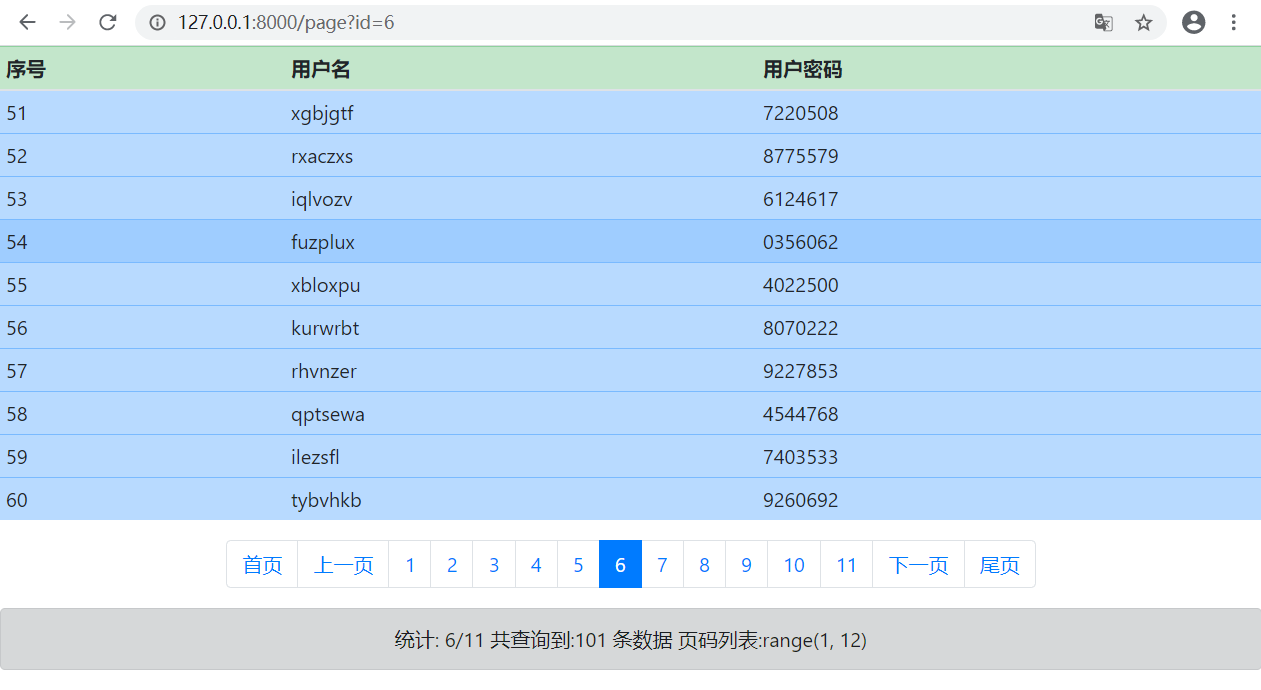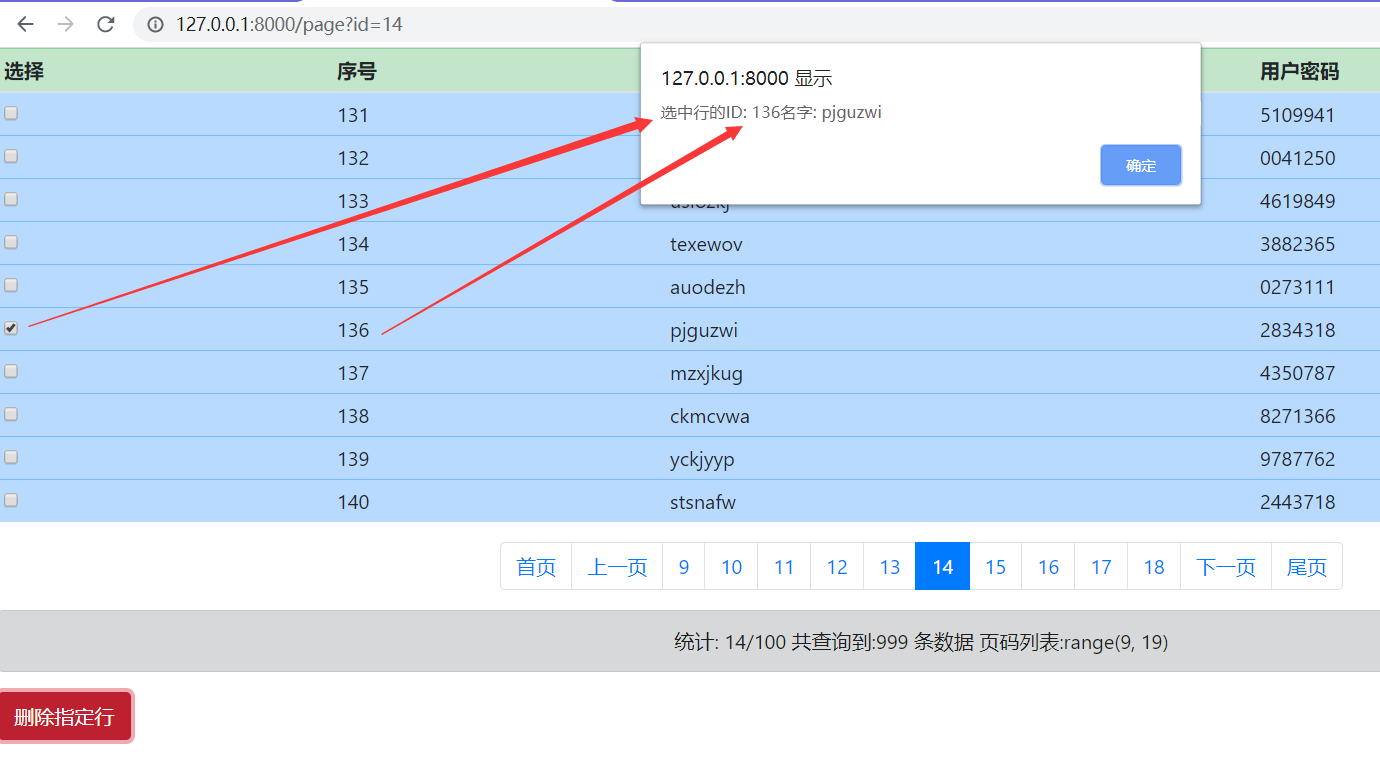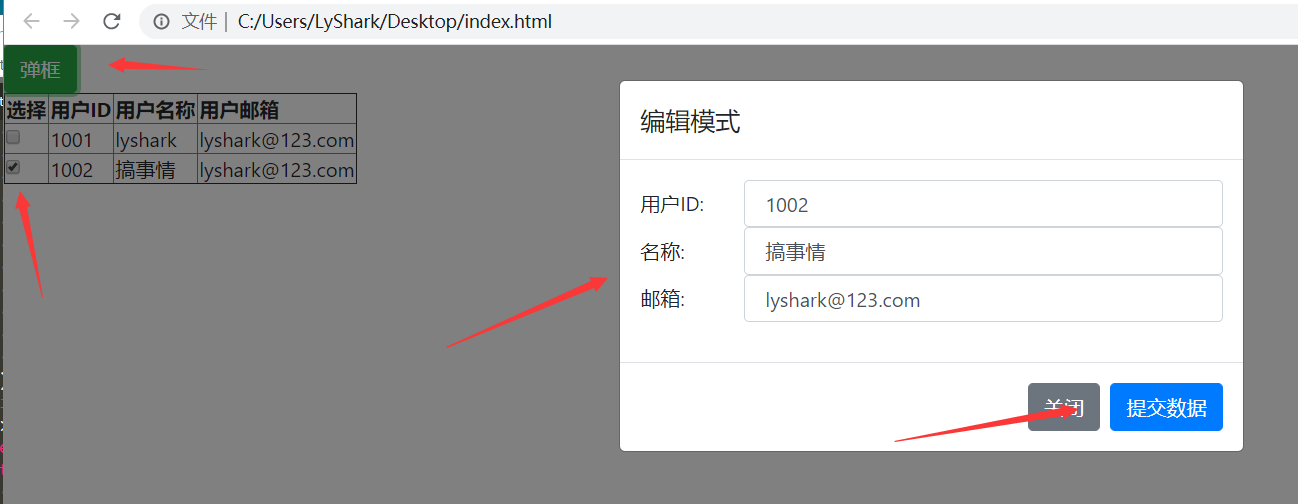您好,登錄后才能下訂單哦!
您好,登錄后才能下訂單哦!
這篇文章主要講解了“Django Paginator分頁器的使用方法”,文中的講解內容簡單清晰,易于學習與理解,下面請大家跟著小編的思路慢慢深入,一起來研究和學習“Django Paginator分頁器的使用方法”吧!
# name: models.py
from django.db import models
class User(models.Model):
id = models.AutoField(primary_key=True)
username = models.CharField(max_length=32)
password = models.CharField(max_length=32)
# 插入測試數據
import random
def index(request):
for i in range(1,100):
chars = []
pasd = []
for x in range(1,8):
chars.append(random.choice('abcdefghijklmnopqrstuvwxyz'))
pasd.append(random.choice('0987654321'))
user = "".join(chars)
pwd = "".join(pasd)
models.User.objects.create(username=user, password=pwd)
return HttpResponse("ok")<!--name: page.html--> <!DOCTYPE html> <html lang="en"> <head> <meta charset="UTF-8"> <title>Title</title> <link rel="stylesheet" href="https://stackpath.bootstrapcdn.com/bootstrap/4.3.1/css/bootstrap.min.css" rel="external nofollow" rel="external nofollow" rel="external nofollow" rel="external nofollow" > </head> <body> <table class="table table-sm table-hover"> <thead> <tr class="table-success"> <th> 序號</th> <th> 用戶名</th> <th> 用戶密碼</th> </tr> </thead> <tbody> {% for article in user_list %} <tr class="table-primary"> <td>{{ article.id }}</td> <td>{{ article.username }}</td> <td>{{ article.password }}</td> </tr> {% endfor %} </tbody> </table> <nav class="d-flex justify-content-center" aria-label="Page navigation example"> <ul class="pagination"> <li class="page-item"><a class="page-link" href="./page?id=1" rel="external nofollow" rel="external nofollow" >首頁</a></li> {% if user_list.has_previous %} <li class="page-item"><a class="page-link" href="./page?id={{ user_list.previous_page_number }}" rel="external nofollow" rel="external nofollow" >上一頁</a></li> {% else %} <li class="page-item disabled"><a class="page-link" href="#" rel="external nofollow" rel="external nofollow" rel="external nofollow" rel="external nofollow" >上一頁</a></li> {% endif %} {% for item in paginator.page_range %} {% if item == currentPage %} <li class="page-item active"><a class="page-link" href="./page?id={{ item }}" rel="external nofollow" rel="external nofollow" rel="external nofollow" rel="external nofollow" rel="external nofollow" rel="external nofollow" rel="external nofollow" rel="external nofollow" >{{ item }}</a></li> {% else %} <li class="page-item"><a class="page-link" href="./page?id={{ item }}" rel="external nofollow" rel="external nofollow" rel="external nofollow" rel="external nofollow" rel="external nofollow" rel="external nofollow" rel="external nofollow" rel="external nofollow" >{{ item }}</a></li> {% endif %} {% endfor %} {% if user_list.has_next %} <li class="page-item"><a class="page-link" href="./page?id={{ user_list.next_page_number }}" rel="external nofollow" rel="external nofollow" >下一頁</a></li> {% else %} <li class="page-item disabled"><a class="page-link" href="#" rel="external nofollow" rel="external nofollow" rel="external nofollow" rel="external nofollow" >下一頁</a></li> {% endif %} <li class="page-item"><a class="page-link" href="./page?id={{ paginator.num_pages }}" rel="external nofollow" rel="external nofollow" >尾頁</a></li> </ul> </nav> <div class="alert alert-dark"> 統計: {{ currentPage }}/{{ paginator.num_pages }} 共查詢到:{{ paginator.count }} 條數據 頁碼列表:{{ paginator.page_range }} </div> </body> </html>
# name: views.py
from django.shortcuts import render,HttpResponse
from MyWeb import models
from django.core.paginator import Paginator, EmptyPage, PageNotAnInteger
def page(request):
user = models.User.objects.all()
paginator = Paginator(user, 10)
currentPage = int(request.GET.get("id",1))
try:
user_list = paginator.page(currentPage)
except PageNotAnInteger:
user_list = paginator.page(1)
except:
user_list = paginator.page(paginator.num_pages)
return render(request,"page.html",{"user_list":user_list,
"paginator":paginator,
"currentPage":currentPage})# name: urls.py
from MyWeb import views
urlpatterns = [
path('admin/', admin.site.urls),
path('page',views.page)
]
上方的分頁代碼還有一個不足之處,當我們的頁碼數量過多時,會全部展示出來,整個頁面都是很不美觀,我們直接在上方代碼上稍加修改一下試試.
# name: views.py
from django.shortcuts import render,HttpResponse
from MyWeb import models
from django.core.paginator import Paginator, EmptyPage, PageNotAnInteger
def page(request):
user = models.User.objects.all()
paginator = Paginator(user, 10)
currentPage = int(request.GET.get("id",1))
if paginator.num_pages > 15:
if currentPage-5 < 1:
pageRange = range(1,11)
elif currentPage+5 > paginator.num_pages:
pageRange = range(currentPage-5,paginator.num_pages)
else:
pageRange = range(currentPage-5,currentPage+5)
else:
pageRange = paginator.page_range
try:
user_list = paginator.page(currentPage)
except PageNotAnInteger:
user_list = paginator.page(1)
except:
user_list = paginator.page(paginator.num_pages)
return render(request,"page.html",{"user_list":user_list,
"paginator":paginator,
"page_range":pageRange, # 此處自定義一個分頁段
"currentPage":currentPage})前端分頁代碼只需要將paginator.page_range改為page_range其他地方不需要動.
{% for item in page_range %}
{% if item == currentPage %}
<li class="page-item active"><a class="page-link" href="./page?id={{ item }}" rel="external nofollow" rel="external nofollow" rel="external nofollow" rel="external nofollow" rel="external nofollow" rel="external nofollow" rel="external nofollow" rel="external nofollow" >{{ item }}</a></li>
{% else %}
<li class="page-item"><a class="page-link" href="./page?id={{ item }}" rel="external nofollow" rel="external nofollow" rel="external nofollow" rel="external nofollow" rel="external nofollow" rel="external nofollow" rel="external nofollow" rel="external nofollow" >{{ item }}</a></li>
{% endif %}
{% endfor %}這樣,無論有多少頁面,都能夠保證只顯示10頁。
1.刪除功能的實現,很簡單,只需要定位得到指定的tr上,取出里面的id號碼,并發送給后端,執行sql刪除就完事了。
<head>
<meta charset="UTF-8">
<title>Title</title>
<link rel="stylesheet" href="https://stackpath.bootstrapcdn.com/bootstrap/4.3.1/css/bootstrap.min.css" rel="external nofollow" rel="external nofollow" rel="external nofollow" rel="external nofollow" >
<script src="https://code.jquery.com/jquery-3.4.1.min.js"></script>
</head>
<body>
<script type="text/javascript">
$(document).ready(function(){
$("#but1").click(function(){
var obj = $("#tab"); // 定位到table表格
var check = $("table input[type=checkbox]:checked");
check.each(function(){ // 遍歷節點
var row = $(this).parent("td").parent("tr"); // 獲取選中行
var id = row.find("[name='uid']").html(); // 取出第一行的屬性
var name = row.find("[name='user']").html();
alert("選中行的ID: " + id + "名字: " + name)
});
});
});
</script>
<table id="tab" class="table table-sm table-hover">
<thead>
<tr class="table-success">
<th>選擇</th><th> 序號</th> <th> 用戶名</th> <th> 用戶密碼</th>
</tr>
</thead>
<tbody>
{% for article in user_list %}
<tr class="table-primary">
<td> <input type="checkbox"></td>
<td name="uid">{{ article.id }}</td>
<td name="user">{{ article.username }}</td>
<td>{{ article.password }}</td>
</tr>
{% endfor %}
</tbody>
</table>
.................
<div>
<button id="but1" class="btn btn-danger" onclick="check()">刪除指定行</button>
</div>
點擊選中行,然后彈出模態框,并自動的獲取到該行數據,編輯好以后直接用ajax發送post請求到后端處理即可。
<head>
<link rel="stylesheet" href="https://stackpath.bootstrapcdn.com/bootstrap/4.3.1/css/bootstrap.min.css" rel="external nofollow" rel="external nofollow" rel="external nofollow" rel="external nofollow" >
<script src="https://code.jquery.com/jquery-3.4.1.slim.min.js"></script>
<script src="https://stackpath.bootstrapcdn.com/bootstrap/4.3.1/js/bootstrap.min.js"></script>
</head>
<button type="button" id="but1" class="btn btn-success" data-toggle="modal" data-target="#staticBackdrop">彈框</button>
<script type="text/javascript">
$(document).ready(function(){
$("#but1").click(function(){
var obj = $("#tab");
var edit = $("table input[type=checkbox]:checked");
edit.each(function(){
var row = $(this).parent("td").parent("tr");
var id = row.find("[name='uid']").html();
var name = row.find("[name='user']").html();
var email = row.find("[name='email']").html();
$("#edit_id").val(id);
$("#edit_name").val(name);
$("#edit_email").val(email);
});
});
});
</script>
<body>
<table id="tab" border="1" cellspacing="0">
<thead>
<tr>
<th>選擇</th><th>用戶ID</th><th>用戶名稱</th><th>用戶郵箱</th>
</tr>
</thead>
<tbody>
<tr>
<td> <input type="checkbox"></td>
<td name="uid"> 1001</td>
<td name="user"> lyshark</td>
<td name="email"> lyshark@123.com</td>
</tr>
<tr>
<td> <input type="checkbox"></td>
<td name="uid"> 1002</td>
<td name="user"> 搞事情</td>
<td name="email"> lyshark@123.com</td>
</tr>
</tbody>
</table>
<div class="modal fade" id="staticBackdrop" data-backdrop="static" aria-hidden="true">
<div class="modal-dialog" role="document">
<div class="modal-content">
<div class="modal-header">
<h6 class="modal-title" id="staticBackdropLabel">編輯模式</h6>
</div>
<div class="modal-body">
<!--主體部分-->
<div class="form-group row">
<label class="col-sm-2 col-form-label">用戶ID:</label>
<div class="col-sm-10">
<input type="text" id="edit_id" class="form-control">
</div>
<label class="col-sm-2 col-form-label">名稱:</label>
<div class="col-sm-10">
<input type="text" id="edit_name" class="form-control">
</div>
<label class="col-sm-2 col-form-label">郵箱:</label>
<div class="col-sm-10">
<input type="text" id="edit_email" class="form-control">
</div>
</div>
</div>
<!--尾部內容-->
<div class="modal-footer">
<button type="button" class="btn btn-secondary" data-dismiss="modal">關閉</button>
<button type="button" class="btn btn-primary">提交數據</button>
</div>
</div>
</div>
</body>
利用BootStrap框架實現分頁: 通過使用bootstrap框架,并配合Django自帶的分頁組件即可實現簡單的分頁效果.
# name: models.py
from django.db import models
class User(models.Model):
id = models.AutoField(primary_key=True)
username = models.CharField(max_length=32)
password = models.CharField(max_length=32)
# 插入測試數據
import random
def index(request):
for i in range(1,1000):
chars = []
pasd = []
for x in range(1,8):
chars.append(random.choice('abcdefghijklmnopqrstuvwxyz'))
pasd.append(random.choice('0987654321'))
user = "".join(chars)
pwd = "".join(pasd)
models.User.objects.create(username=user, password=pwd)
return HttpResponse("ok")<!--name: page.html-->
<!DOCTYPE html>
<html lang="en">
<head>
<meta charset="UTF-8">
<title>Title</title>
<link rel="stylesheet" href="https://stackpath.bootstrapcdn.com/bootstrap/4.3.1/css/bootstrap.min.css" rel="external nofollow" rel="external nofollow" rel="external nofollow" rel="external nofollow" >
</head>
<body>
<table class="table table-sm table-hover">
<thead>
<tr class="table-success">
<th> 序號</th> <th> 用戶名</th> <th> 用戶密碼</th>
</tr>
</thead>
<tbody>
{% for article in user_list %}
<tr class="table-primary">
<td>{{ article.id }}</td>
<td>{{ article.username }}</td>
<td>{{ article.password }}</td>
</tr>
{% endfor %}
</tbody>
</table>
<nav class="d-flex justify-content-center" aria-label="Page navigation example">
<ul class="pagination">
<li class="page-item"><a class="page-link" href="./page?id=1" rel="external nofollow" rel="external nofollow" >首頁</a></li>
{% if user_list.has_previous %}
<li class="page-item"><a class="page-link" href="./page?id={{ user_list.previous_page_number }}" rel="external nofollow" rel="external nofollow" >上一頁</a></li>
{% else %}
<li class="page-item disabled"><a class="page-link" href="#" rel="external nofollow" rel="external nofollow" rel="external nofollow" rel="external nofollow" >上一頁</a></li>
{% endif %}
{% for item in paginator.page_range %}
{% if item == currentPage %}
<li class="page-item active"><a class="page-link" href="./page?id={{ item }}" rel="external nofollow" rel="external nofollow" rel="external nofollow" rel="external nofollow" rel="external nofollow" rel="external nofollow" rel="external nofollow" rel="external nofollow" >{{ item }}</a></li>
{% else %}
<li class="page-item"><a class="page-link" href="./page?id={{ item }}" rel="external nofollow" rel="external nofollow" rel="external nofollow" rel="external nofollow" rel="external nofollow" rel="external nofollow" rel="external nofollow" rel="external nofollow" >{{ item }}</a></li>
{% endif %}
{% endfor %}
{% if user_list.has_next %}
<li class="page-item"><a class="page-link" href="./page?id={{ user_list.next_page_number }}" rel="external nofollow" rel="external nofollow" >下一頁</a></li>
{% else %}
<li class="page-item disabled"><a class="page-link" href="#" rel="external nofollow" rel="external nofollow" rel="external nofollow" rel="external nofollow" >下一頁</a></li>
{% endif %}
<li class="page-item"><a class="page-link" href="./page?id={{ paginator.num_pages }}" rel="external nofollow" rel="external nofollow" >尾頁</a></li>
</ul>
</nav>
<div class="alert alert-dark">
統計: {{ currentPage }}/{{ paginator.num_pages }} 共查詢到:{{ paginator.count }} 條數據 頁碼列表:{{ paginator.page_range }}
</div>
</body>
</html># name: views.py
from django.shortcuts import render,HttpResponse
from MyWeb import models
from django.core.paginator import Paginator, EmptyPage, PageNotAnInteger
def page(request):
user = models.User.objects.all()
paginator = Paginator(user, 10)
currentPage = int(request.GET.get("id",1))
try:
user_list = paginator.page(currentPage)
except PageNotAnInteger:
user_list = paginator.page(1)
except:
user_list = paginator.page(paginator.num_pages)
return render(request,"page.html",{"user_list":user_list,
"paginator":paginator,
"currentPage":currentPage})# name: urls.py
from MyWeb import views
urlpatterns = [
path('admin/', admin.site.urls),
path('page',views.page)
]上方的分頁代碼還有一個不足之處,當我們頁面中的頁碼數量過多時,默認會將頁碼全部展示出來,整個頁面看上去很不美觀,我們可以直接在上方分頁代碼上稍加修改即可,如下代碼.
# name: views.py
from django.shortcuts import render,HttpResponse
from MyWeb import models
from django.core.paginator import Paginator, EmptyPage, PageNotAnInteger
def page(request):
user = models.User.objects.all()
paginator = Paginator(user, 10)
currentPage = int(request.GET.get("id",1))
if paginator.num_pages > 15:
if currentPage-5 < 1:
pageRange = range(1,11)
elif currentPage+5 > paginator.num_pages:
pageRange = range(currentPage-5,paginator.num_pages)
else:
pageRange = range(currentPage-5,currentPage+5)
else:
pageRange = paginator.page_range
try:
user_list = paginator.page(currentPage)
except PageNotAnInteger:
user_list = paginator.page(1)
except:
user_list = paginator.page(paginator.num_pages)
return render(request,"page.html",{"user_list":user_list,
"paginator":paginator,
"page_range":pageRange, # 此處自定義一個分頁段
"currentPage":currentPage})前端分頁代碼只需要將paginator.page_range改為page_range其他地方不需要動.
{% for item in page_range %}
{% if item == currentPage %}
<li class="page-item active"><a class="page-link" href="./page?id={{ item }}" rel="external nofollow" rel="external nofollow" rel="external nofollow" rel="external nofollow" rel="external nofollow" rel="external nofollow" rel="external nofollow" rel="external nofollow" >{{ item }}</a></li>
{% else %}
<li class="page-item"><a class="page-link" href="./page?id={{ item }}" rel="external nofollow" rel="external nofollow" rel="external nofollow" rel="external nofollow" rel="external nofollow" rel="external nofollow" rel="external nofollow" rel="external nofollow" >{{ item }}</a></li>
{% endif %}
{% endfor %}layui是一個完整的前端開發框架,利用它可以快速構建分頁應用,比BootStrap更加靈活.
# models.py from django.db import models class HostDB(models.Model): id = models.AutoField(primary_key=True) hostname = models.CharField(max_length=64) hostaddr = models.CharField(max_length=64) hostmode = models.CharField(max_length=64)
<!--name: index.html-->
<!DOCTYPE html>
<html lang="en">
<head>
<meta charset="UTF-8">
<link rel="stylesheet" href="https://lyshark.com/cdn/layui/css/layui.css" rel="external nofollow" rel="external nofollow" >
<script type="text/javascript" src="https://lyshark.com/cdn/layui/layui.js"></script>
</head>
<body>
<table class="layui-hide" id="demo"></table>
<script type="text/javascript">
layui.use('table', function(){
var table = layui.table;
table.render({
elem: '#demo',
url:'/get_page',
method:'get',
toolbar: '#toolbarDemo' // 顯示工具條
,request: {
pageName: 'pageIndex', // 頁碼的參數名稱,默認:page
limitName: 'pageSize' // 每頁數據量的參數名,默認:limit
}
,response: {
statusName: 'code', // 規定數據狀態的字段名稱,默認:code
statusCode: 0, // 規定成功的狀態碼,默認:0
msgName: 'msg', // 規定狀態信息的字段名稱,默認:msg
countName: 'DataCount', // 規定數據總數的字段名稱,默認:count
dataName: 'data' // 規定數據列表的字段名稱,默認:data
}
,cols: [[
{type: 'checkbox', fixed: 'left'},
{field:'id', title:'主機ID', width:100, sort: true},
{field:'hostname', title:'主機名稱', width:120},
{field:'hostaddr', title:'主機地址', width:120},
{field:'hostmode', title:'主機組', width:120},
]]
,page: {
layout: ['limit', 'count', 'prev', 'page', 'next', 'skip'], // 自定義分頁布局
curr: 1, // 設置默認起始頁1
groups: 10, //只顯示10個連續頁碼,就是說顯示10個可見頁其他的省略
first: false, // 不顯示首頁
last: false // 不顯示尾頁
},
limit: 5,
limits: [5,10,15,20,25]
});
});
</script>
</body>
</html># views.py
from django.shortcuts import render,HttpResponse
from django.core.paginator import Paginator,EmptyPage,PageNotAnInteger
from MyWeb import models
import json
def index(request):
return render(request,"index.html")
def get_page(request):
data = models.HostDB.objects.all()
dataCount = data.count()
pageIndex = request.GET.get("pageIndex")
pageSize = request.GET.get("pageSize")
print("當前索引:{} 當前大小:{}".format(pageIndex,pageSize))
print("所有記錄:{} 數據總條數:{}".format(data,dataCount))
# 將數據組裝成字典后放入data_list列表
data_list,ref_data = [],[]
for item in data:
dict = { 'id':item.id , 'hostname':item.hostname, 'hostaddr':item.hostaddr, 'hostmode':item.hostmode }
data_list.append(dict)
# 使用分頁器分頁
pageInator = Paginator(data_list,pageSize)
context = pageInator.page(pageIndex)
for item in context:
ref_data.append(item)
# 返回分頁格式
data = { "code": 0,"msg": "ok","DataCount": dataCount,"data": ref_data }
return HttpResponse(json.dumps(data))# name: url.py
from MyWeb import views
urlpatterns = [
path('admin/', admin.site.urls),
path('',views.index),
path('get_page/',views.get_page)
]通過使用layui框架完成的一個相對完整的表格分頁,可用于生產環境.
<!--name: index.html-->
<!DOCTYPE html>
<html lang="en">
<head>
<meta charset="UTF-8">
<link rel="stylesheet" href="https://lyshark.com/cdn/layui/css/layui.css" rel="external nofollow" rel="external nofollow" >
<script type="text/javascript" src="https://lyshark.com/cdn/jquery/jquery3.js"></script>
<script type="text/javascript" src="https://lyshark.com/cdn/layui/layui.js"></script>
</head>
<body>
<div class="demoTable">
<div class="layui-inline">
<input class="layui-input" name="id" id="demoReload" autocomplete="off">
</div>
<button class="layui-btn" data-type="reload">搜索</button>
</div>
<script type="text/html" id="barDemo">
<a class="layui-btn layui-btn-xs" lay-event="edit">編輯</a>
<a class="layui-btn layui-btn-danger layui-btn-xs" lay-event="del">刪除</a>
</script>
<table class="layui-hide" id="demo" lay-filter="test"></table>
<script type="text/javascript">
layui.use('table', function(){
var table = layui.table;
table.render({
elem: '#demo',
id: 'testReload',
url:'/get_page',
method:'get'
,request: {
pageName: 'pageIndex', // 頁碼的參數名稱,默認:page
limitName: 'pageSize' // 每頁數據量的參數名,默認:limit
}
,response: {
statusName: 'code', // 規定數據狀態的字段名稱,默認:code
statusCode: 0, // 規定成功的狀態碼,默認:0
msgName: 'msg', // 規定狀態信息的字段名稱,默認:msg
countName: 'DataCount', // 規定數據總數的字段名稱,默認:count
dataName: 'data' // 規定數據列表的字段名稱,默認:data
}
,cols: [[
{type: 'checkbox', fixed: 'left'},
{field:'id', title:'主機ID', width:100, sort: true},
{field:'hostname', title:'主機名稱', width:120},
{field:'hostaddr', title:'主機地址', width:120},
{field:'hostmode', title:'主機組', width:120},
{fixed: 'right', title:'操作', toolbar: '#barDemo', width:120}
]]
,page: {
layout: ['limit', 'count', 'prev', 'page', 'next', 'skip'], // 自定義分頁布局
curr: 1, // 設置默認起始頁1
groups: 10, // 只顯示10個連續頁碼,就是說顯示10個可見頁其他的省略
first: false, // 不顯示首頁
last: false // 不顯示尾頁
},
limit: 5,
limits: [5,10,15,20,25]
});
// ------------------------------------------------------------------
// 監聽行工具事件:也就是編輯與刪除的處理事件
table.on('tool(test)', function(obj){
var data = obj.data;
if(obj.event === 'del'){
layer.confirm('真的要刪除本行數據嗎 ?', {icon: 3,anim: 2}, function(index){
// console.log("待刪除ID: " + obj.data['id']);
$.ajax({
url:"/delete_page/",
type:"get",
data: {"id":obj.data['id']},
success:function (recv) {
layer.msg("刪除完成了..", {icon: 6});
}
});
obj.del();
layer.close(index);
});
} else if(obj.event === 'edit'){
layer.prompt({ formType:2, title: "編輯表格",btn:['修改數據','關閉'],anim: 4,
content:`<div>
主機序號: <input type="text" style='display:inline-block' id="id"><br><br>
主機名稱: <input type="text" style='display:inline-block' id="hostname"><br><br>
主機地址: <input type="text" style='display:inline-block' id="hostaddr"><br><br>
主機屬組: <input type="text" style='display:inline-block' id="hostmode"><br><br>
</div>`,
yes:function (index,layero)
{
console.log("點擊yes觸發事件:" + index);
var id = $("#id").val();
var hostname = $("#hostname").val();
var hostaddr = $("#hostaddr").val();
var hostmode = $("#hostmode").val();
$.ajax({
url: "/update_page",
type: "get",
data: {"id": id,
"hostname": hostname,
"hostaddr": hostaddr,
"hostmode": hostmode },
success:function (recv) {
// 修改完成后,本地直接更新數據,這樣就無需刷新一次了
obj.update({
hostname: hostname,
hostaddr: hostaddr,
hostmode: hostmode
});
layer.msg("修改完成了..", {icon: 6});
layer.close(index);
}
});
}
});
$("#id").val(data.id);
$("#hostname").val(data.hostname);
$("#hostaddr").val(data.hostaddr);
$("#hostmode").val(data.hostmode);
}
});
// 搜索后的重載,也就是找到數據以后直接更新
var $ = layui.$, active = {
reload: function(){
var demoReload = $('#demoReload');
//執行重載
table.reload('testReload', {
url:"/search_page",
page: {
curr: 1,
limits: [1]
}
,where: {
hostname: demoReload.val()
}
});
}
};
// ---------------------------------------------------------
// 綁定搜索事件
$('.demoTable .layui-btn').on('click', function(){
var type = $(this).data('type');
active[type] ? active[type].call(this) : '';
});
});
</script>
</body>
</html># name:views.py
from django.shortcuts import render,HttpResponse
from django.core.paginator import Paginator,EmptyPage,PageNotAnInteger
from MyWeb import models
import json
def index(request):
return render(request,"index.html")
def get_page(request):
data = models.HostDB.objects.all()
dataCount = data.count()
pageIndex = request.GET.get("pageIndex")
pageSize = request.GET.get("pageSize")
print("當前索引:{} 當前大小:{}".format(pageIndex,pageSize))
print("所有記錄:{} 數據總條數:{}".format(data,dataCount))
list = []
res = []
for item in data:
dict = {}
dict['id'] = item.id
dict['hostname'] = item.hostname
dict['hostaddr'] = item.hostaddr
dict['hostmode'] = item.hostmode
list.append(dict)
pageInator = Paginator(list,pageSize)
context = pageInator.page(pageIndex)
for item in context:
res.append(item)
data = { "code": 0,"msg": "ok","DataCount": dataCount,"data": res }
return HttpResponse(json.dumps(data))
def search_page(request):
sql = request.GET.get("hostname")
data = models.HostDB.objects.all().filter(hostname=sql)
list = []
for item in data:
dict = {}
dict['id'] = item.id
dict['hostname'] = item.hostname
dict['hostaddr'] = item.hostaddr
dict['hostmode'] = item.hostmode
list.append(dict)
data = { "code": 0,"msg": "ok","DataCount": 1,"data": list }
return HttpResponse(json.dumps(data))
def delete_page(request):
get_id = request.GET.get("id")
models.HostDB.objects.filter(id=get_id).delete()
return render(request,"index.html")
def update_page(request):
get_id = request.GET.get("id")
get_hostname = request.GET.get("hostname")
get_hostaddr = request.GET.get("hostaddr")
get_hostmode = request.GET.get("hostmode")
print(get_hostmode)
obj = models.HostDB.objects.get(id=get_id)
obj.hostname = get_hostname
obj.hostaddr = get_hostaddr
obj.hostmode = get_hostmode
obj.save()
return render(request,"index.html")# name: urls.py
from MyWeb import views
urlpatterns = [
path('',views.index),
path('get_page/',views.get_page),
path('search_page/',views.search_page),
path('delete_page/',views.delete_page),
path("update_page/",views.update_page)
]轉載代碼,僅用于收藏。
from urllib.parse import urlencode
class Pagination(object):
def __init__(self,current_page,total_count,base_url,params,per_page_count=10,max_pager_count=10):
try:
current_page = int(current_page)
except Exception as e:
current_page = 1
if current_page <= 1:
current_page = 1
self.current_page = current_page
# 數據總條數
self.total_count = total_count
# 每頁顯示10條數據
self.per_page_count = per_page_count
# 頁面上應該顯示的最大頁碼
max_page_num, div = divmod(total_count, per_page_count)
if div:
max_page_num += 1
self.max_page_num = max_page_num
# 頁面上默認顯示11個頁碼(當前頁在中間)
self.max_pager_count = max_pager_count
self.half_max_pager_count = int((max_pager_count - 1) / 2)
# URL前綴
self.base_url = base_url
# request.GET
import copy
params = copy.deepcopy(params)
# params._mutable = True
get_dict = params.to_dict()
# 包含當前列表頁面所有的搜/索條件
self.params = get_dict
@property
def start(self):
return (self.current_page - 1) * self.per_page_count
@property
def end(self):
return self.current_page * self.per_page_count
def page_html(self):
# 如果總頁數 <= 11
if self.max_page_num <= self.max_pager_count:
pager_start = 1
pager_end = self.max_page_num
# 如果總頁數 > 11
else:
# 如果當前頁 <= 5
if self.current_page <= self.half_max_pager_count:
pager_start = 1
pager_end = self.max_pager_count
else:
# 當前頁 + 5 > 總頁碼
if (self.current_page + self.half_max_pager_count) > self.max_page_num:
pager_end = self.max_page_num
pager_start = self.max_page_num - self.max_pager_count + 1 #倒這數11個
else:
pager_start = self.current_page - self.half_max_pager_count
pager_end = self.current_page + self.half_max_pager_count
page_html_list = []
# {source:[2,], status:[2], gender:[2],consultant:[1],page:[1]}
# 首頁
self.params['page'] = 1
first_page = '首頁' % (self.base_url,urlencode(self.params),)
page_html_list.append(first_page)
# 上一頁
self.params["page"] = self.current_page - 1
if self.params["page"] <= 1:
pervious_page = '上一頁' % (self.base_url, urlencode(self.params))
else:
pervious_page = '上一頁' % ( self.base_url, urlencode(self.params))
page_html_list.append(pervious_page)
# 中間頁碼
for i in range(pager_start, pager_end + 1):
self.params['page'] = i
if i == self.current_page:
temp = '%s' % (self.base_url,urlencode(self.params), i,)
else:
temp = '%s' % (self.base_url,urlencode(self.params), i,)
page_html_list.append(temp)
# 下一頁
self.params["page"] = self.current_page + 1
if self.params["page"] > self.max_page_num:
self.params["page"] = self.current_page
next_page = '下一頁' % (self.base_url, urlencode(self.params))
else:
next_page = '下一頁' % (self.base_url, urlencode(self.params))
page_html_list.append(next_page)
# 尾頁
self.params['page'] = self.max_page_num
last_page = '尾頁' % (self.base_url, urlencode(self.params),)
page_html_list.append(last_page)
return ''.join(page_html_list)感謝各位的閱讀,以上就是“Django Paginator分頁器的使用方法”的內容了,經過本文的學習后,相信大家對Django Paginator分頁器的使用方法這一問題有了更深刻的體會,具體使用情況還需要大家實踐驗證。這里是億速云,小編將為大家推送更多相關知識點的文章,歡迎關注!
免責聲明:本站發布的內容(圖片、視頻和文字)以原創、轉載和分享為主,文章觀點不代表本網站立場,如果涉及侵權請聯系站長郵箱:is@yisu.com進行舉報,并提供相關證據,一經查實,將立刻刪除涉嫌侵權內容。